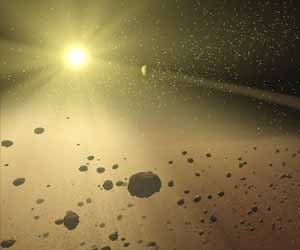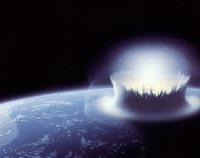|
|
Asteroid Belt
Tweet
Facts and Information
Asteroid 951 Gaspra
 Close up image of a 10 mile (17 km) long asteroid
Close up image of a 10 mile (17 km) long asteroid
Arizona impact crater
 Meteor crater in the Arizona desert, also known as the Barringer Crater. It is over 1 kilometer in diameter
Meteor crater in the Arizona desert, also known as the Barringer Crater. It is over 1 kilometer in diameter
Asteroid Belt Facts
- There are 200 objects in the asteroid belt larger than 60 miles (100 km) in diameter and almost 1 million objects over 1 km in diameter.
- The average surface temperature of an asteroid is -73C (-100F).
- The largest asteroid Ceres was the first to be discovered in 1801, it has recently been re-classified as a dwarf planet.
- Asteroids are rich in minerals, the estimated wealth of the asteroid belt is 100 billion dollars for every person on Earth today.
- The study of asteroids can give us a valuable insight into how the planets formed.
- A meteorite is any fragment from a body, such as an asteroid, which manages to pass through our atmosphere and land on Earth.
- Some asteroids orbit in the inner solar system and indeed some even cross the orbit of Earth, these are known as Near Earth Objects (NEO).
- It is believed an asteroid impact in the Gulf of Mexico was responsible for the extinction of the dinosaurs 65 million years ago.
The Asteroid Belt
 Artist's impression of the asteroid belt
The asteroid belt is situated between the orbits of Mars and Jupiter around 280 million miles (450 million km) from the sun. There are millions of asteroids residing
in this area ranging from 600 miles (950 km) in diameter, all the way down to particles of dust. It is believed asteroids are the remnants from the formation of the planets.
Although there are millions of objects in the asteroid belt it is not densely populated, they are scattered over a vast area, several spacecraft have passed through the belt
on they're way to the outer planets without encountering any issues. The main danger we face on Earth from the asteroid belt is that objects escape from the region and collide with the planets
and moons in our solar system. Near Earth asteroids are tracked by NASA and other
organizations.
Artist's impression of the asteroid belt
The asteroid belt is situated between the orbits of Mars and Jupiter around 280 million miles (450 million km) from the sun. There are millions of asteroids residing
in this area ranging from 600 miles (950 km) in diameter, all the way down to particles of dust. It is believed asteroids are the remnants from the formation of the planets.
Although there are millions of objects in the asteroid belt it is not densely populated, they are scattered over a vast area, several spacecraft have passed through the belt
on they're way to the outer planets without encountering any issues. The main danger we face on Earth from the asteroid belt is that objects escape from the region and collide with the planets
and moons in our solar system. Near Earth asteroids are tracked by NASA and other
organizations.
Asteroids - The Threat to Earth

Future Missions to the Asteroid Belt
Dawn
 Launch: September 2007
Launch: September 2007Arrival: July 2011
Agency: NASA
Dawn will be the first spacecraft to orbit one object then after a period of time leave and continue to another body, this is thanks to its ion propulsion engine (pictured left). Although far less powerful than a conventional chemical rocket, ion engines are a lot more fuel efficient, allowing them to run for years.
Dawn will study two objects in the asteroid belt, the large asteroid Vesta and the dwarf planet Ceres. It is due to reach Vesta in July 2011, it will orbit the asteroid for a year then continue on to Ceres, it will study the dwarf planet over a period of 5 months between February and July 2015.
The goal of the mission is to characterize the conditions of the early solar system and the role of size and water in determining the evolution of the planets.
Images and Videos
Meteor landing in Canada
Approach of Eros
Asteroid with its own moon

